
Working out on keto sparks a lot of questions, especially when it comes to combining high intensity workouts (HIIT) with a low carb lifestyle. The idea of pushing yourself to the limit while your body runs on fat instead of carbs seems a little odd at first, but it’s definitely doable, and there are ways to make it work for your routine.
Most people hear “keto” and think about losing fat at a steady, gentle pace. But what about those days you want to really go hard in the gym or during a sprint session? High intensity workouts have their own demands, and if you’re eating ultra low carb, your body will handle things a bit differently. Here’s what I’ve found out from experience, research, and helping friends tweak their routines: keto and HIIT aren’t enemies, but they do call for a little planning.
Working out with high intensity on keto isn’t for everyone, but if you want to keep your performance up and stick to your nutrition goals, there’s plenty to know. Here’s an all-in-one rundown on how keto and high intensity exercise mix, what really happens in your body, and what to expect if you decide to give it a go. If you’re considering making the switch or just curious, read on as we break things down.
Understanding High Intensity Workouts on Keto
High intensity workouts (think sprints, functional fitness, plyometrics, or short bursts of all out effort) usually run on carbohydrates. Carbs turn into glucose, which is super quick fuel for explosive movement. Keto, on the other hand, switches your main source of fuel to fat, sometimes making HIIT a bit more challenging, especially in the beginning. This adaptation phase is temporary for most, but adjusting can require tweaks to diet and training.
Can You Do HIIT on Keto?
It’s definitely possible to do high intensity workouts on keto, and lots of people do it regularly. Performance might drop at first if you’ve just switched to a keto diet, because your body is still teaching itself to use fat and ketones for energy. After this adjustment phase (which can take a couple weeks or so), energy levels tend to bounce back, and some people even say their endurance improves.
It works best if you’ve had time to become fully “fat adapted,” which just means your body is good at burning fat for fuel. When you reach that point, you can do most workouts—HIIT included—without crashing. But if you’re still in the early days of keto or switch back and forth a lot, HIIT sessions are going to feel way harder than they need to be. Making steady progress during those first weeks is key to ensuring you stick with it long enough to see results.
What Happens When You Work Out Intensely on Keto?
The science of keto plus intense exercise comes down to the type of fuel your muscles use. During short, all out efforts, muscle cells want quick access energy (glycogen). On keto, glycogen stores are lower, so you rely more on fat and ketones. Here’s what actually goes down:
- Reduced muscle glycogen: With fewer carbs in your diet, stored energy in your muscles drops. That can lead to feeling a bit slower or weaker with sprint style exercise, at least until your body adapts.
- More fat and ketone burning: After adaptation, your body gets much better at burning fat and ketones for energy, even when the effort ramps up. That’s why some endurance folks thrive on keto.
- Possible performance dip (at first): New to keto? HIIT might feel lousy until your metabolism finishes switching gears. Give it time, and don’t be surprised if you set a few new PRs once fat adaptation kicks in.
- Muscle recovery changes: Lower insulin and different hormone profiles on keto may mean some athletes recover differently. Some people need more rest between HIIT sessions or benefit from adding more electrolytes and protein.
There are ways to help your body handle the switch. Some folks use targeted keto (adding a small amount of fast carbs before HIIT) or cyclical keto (cycling in carbs on workout days). These tweaks can help if you’re doing a lot of explosive training or if your energy still isn’t where you want it. If fat loss or training consistency is your goal, experimenting with these approaches can make a real difference.
Additionally, while keto gives a boost to fat burning, certain individuals may experience a learning curve in terms of energy management and pacing. Being flexible and patient with your body as you try new routines is essential. Try to log your sessions and any energy fluctuations, to help fine-tune what works best for you.
HIIT vs. Steady State Cardio for Fat Loss on Keto
HIIT is popular because it burns a lot of calories fast, can turn up metabolic rate for hours, and doesn’t take much time. People also think it’s the “magic bullet” for fat loss, but on keto, or even a regular diet, HIIT isn’t always better than good old steady state cardio (like jogging or walking).
Why HIIT Isn’t Automatically Better for Fat Loss
- Overall calories burned matter most. HIIT is intense but short. Steady state cardio burns less per minute, but you can go longer, so you might burn the same or more calories overall if you stick with it.
- Recovery demands go up. If you go all out in HIIT and burn out, you might skip sessions or slow down the rest of the week. Fat loss depends on staying active and consistent.
- Hunger can increase after HIIT. Some people find their appetite spikes after really intense sessions, which can make sticking to a calorie deficit (key for fat loss) a lot harder.
- Your diet is still the main player. No workout can outdo an eating plan that isn’t on track, and keto keeps your insulin lower, helping some people lose fat even with more moderate training.
Steady state cardio works great on keto since your body is already good at burning fat. Mixing in both HIIT and steady sessions can also help keep things interesting and cover all your fitness bases. Remember, the best program is the one you stick with—consistency wins the long game.
Working Out on Hyper Ketosis: Is It Okay?
Hyper ketosis means you have higher than usual levels of ketones in your blood. This usually happens from a super strict keto diet or fasting, and can be safe for many people who aren’t managing type 1 diabetes. When you’re in hyper ketosis and exercise hard, here’s what usually happens:
- Increased fat burning: High ketone levels are a sign your body is burning lots of fat. If you’re feeling good, working out is totally fine, just pay attention to how your body responds.
- Watch for warning signs: Feeling dizzy, overly fatigued, or nauseated is a sign to slow down. Hydration and electrolytes matter even more here, since keto tends to flush out minerals.
- Possible adaptation benefit: Some research suggests higher ketones might actually improve endurance once you’ve adjusted, but go easy when trying out any new protocol.
Just a heads up: if you manage a medical condition or ever see really high ketone numbers combined with high blood sugar, check with a doctor. But for most low carb fans, being in deep ketosis and working out is pretty normal, especially if you listen to your body and address hydration. If you’re noticing performance dips beyond the norm, adjusting your nutrition or rest days can help.
Tips for Doing High Intensity Workouts on Keto
- Start slow, especially in your first few weeks, and increase the intensity as you feel more comfortable.
- Stay hydrated. Sodium, magnesium, and potassium help keep energy and performance up; keto diets need more of them naturally.
- Consider targeted carbs (like a preworkout banana or a few rice cakes) if you’re serious about explosive, powerbased sports and aren’t getting enough energy.
- Track your workouts, and don’t stress if your numbers dip for a short time. Most keto athletes see things rebound after a month or two.
- Prioritize protein for muscle recovery, and aim for quality sleep. Keto can change your normal recovery cues, so listening to your body is super important.
- Remember that adding light activity or simple stretching on rest days will also help your body recover and may help prevent stiffness.
- If motivation wanes, team up with a workout buddy or join online communities for support—staying connected can give a boost to your consistency.
Common Questions About Keto and High Intensity Exercise
Can you build muscle with HIIT on keto?
You can, but progress may be slower in the first weeks while your body adapts. Eating enough protein and keeping calories up (if you want to build) is key. Adding in resistance training can speed things along. Consistency in your daily meals helps your body shift toward muscle gain mode, even while carbs are low.
Will high intensity exercise kick me out of ketosis?
For most people, occasional high intensity exercise won’t end ketosis, especially if your carb intake is steady and low. Your body might use up some muscle glycogen, but unless you’re eating lots of carbs, you’ll stay in fatburning mode. If you track your ketones, you might notice slight dips after workouts, which is a normal part of the process.
What’s the best preworkout meal on keto?
Options like eggs, a little avocado, or even a small portion of berries can work well. If you need more punch, a targeted bit of carbs 30 minutes before training can give you a quick boost. Experiment with timing and portions until you find what feels best.
Next Steps: Finding Your Balance with Keto and Intense Training
- Give yourself a few weeks to get fat adapted before jumping into tough workouts.
- Mix up your training—throw in HIIT, steady cardio, and strength work for the best results.
- Take notes on how your body feels, energy levels, and recovery. Adjust as needed each week.
- If you track macros or use training apps, check in regularly and tweak your nutrition as needed to support both performance and wellness.
- Consider seeking advice or feedback in keto or fitness forums, as sharing experiences can lead to helpful discoveries you might not stumble upon alone.
Keto and high intensity workouts can totally go hand in hand; you just need a little patience and the right adjustments. If you’re curious about trying HIIT on keto, jump into the routine and see how it works for your goals. Share your questions or results, and compare notes with other athletes in the community on your adventure to better health and next-level cool performance.
